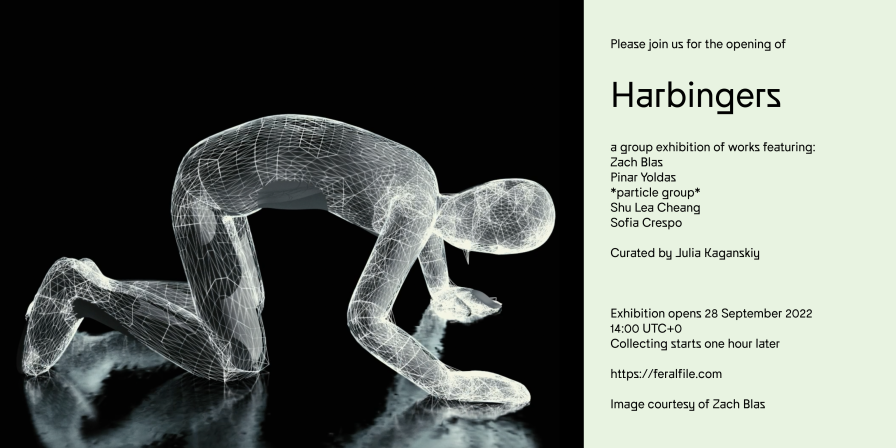Feral File | Website

Transhumanist Desires & Technogenic Anxieties
For millennia, speculations about how technoscientific innovations could transform living organisms — by accident or design — have animated our imaginaries of cyborgs, mutants, automatons, and replicants. As our environment becomes increasingly synthetic, polluted, and governed by planetary-scale computation, what kind of lifeforms will it support?
The group show Harbingers brings together a bestiary of the posthuman, assembling artistic visions of transhumanist desires and technogenic anxieties in an age of accelerated biosocial transformation. A menagerie of mutant creatures emerges from the recombinant crucible of computational manipulation, genetic engineering, viral mutation, biohacking, and cross-species contamination. Novel corporeal formations, at once familiar and strange, are produced through complex interrelations of nature, culture, and technology. Modernity becomes an agent of metamorphosis through the vectors of engineering, adaptation, and aberration. Each work in Harbingers offers a portal into a fabulated mirror world governed by its own mythology. The organisms assembled here include coded chimeras, genetically modified superhumans, bodies held captive by the algorithmic surround, and plants and animals that have evolved to metabolize plastics and toxic waste. All serve as sentinels of the transfigurative powers of technology and ecocide.
Taking mutation, mutability, and human-machine entanglement as its organizing principles, Harbingers also pays particular attention to how art circulates within the media environment of blockchain-enabled cultural production. From the blockchain’s much debated environmental impact to its emphasis on financial speculation and promise to remake the web in its own image, it portends a future where, as writer Alexander Iadarola puts it, “like microplastics, speculation has leaked into everything.” As such, the works in Harbingers will leverage blockchain data to “infect” each NFT. Once a work is purchased, each subsequent sale recorded on the blockchain will trigger a random glitching process that will cause the file to morph and mutate, progressively distorting its image and audio with each sale transaction.
This intervention serves to highlight the materiality of digital media, emphasizing the importance of maintenance, care, and stewardship in the preservation of digital art and the responsibilities inherent in becoming a collector. It also calls into question claims of the blockchain’s “immutability,” for the works themselves will change every time they change hands. This gesture asks us to consider how blockchain technology is poised to catalyze radical transformations in both virtual and physical domains — whether as emergent forms of culture and creative expression, new social structures and forms of governance, or as resource-intensive technological systems.
A harbinger is a kind of avatar, a premonition of what’s to come, a haunting from the future. It can be seen as a signal anticipating future events or as an instigator that creates the conditions of their possibility, actively bringing them into existence. The ambiguity inherent in this process of co-production or co-evolution — which came first, the signal or the event? The latter is always already present by the time the signal is received — is at the very heart of the idea of speculation. Through speculation we not only imagine possible futures but also place bets on their becoming real, participating in their emergence. Investment itself can become a self-fulfilling prophecy. That which we pay attention to grows. The works in this show ask us to pay closer attention to the signals of transformation that surround us today and to consider what kind of visions of the future we’re betting on.
Curated by Julia Kaganskiy
